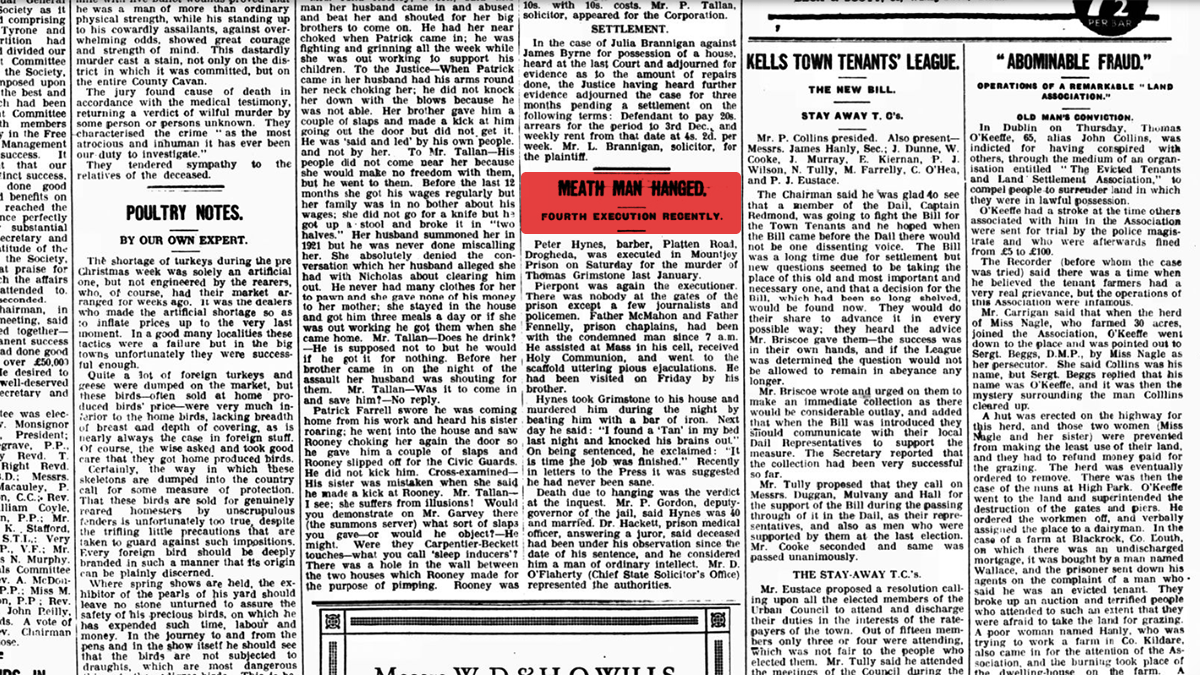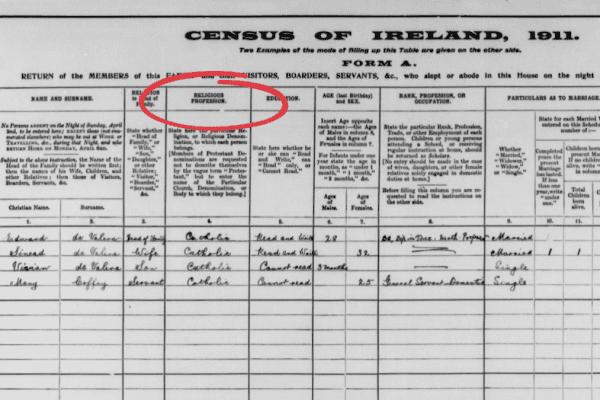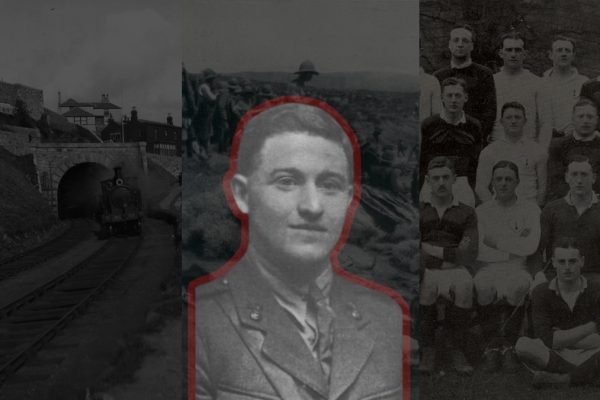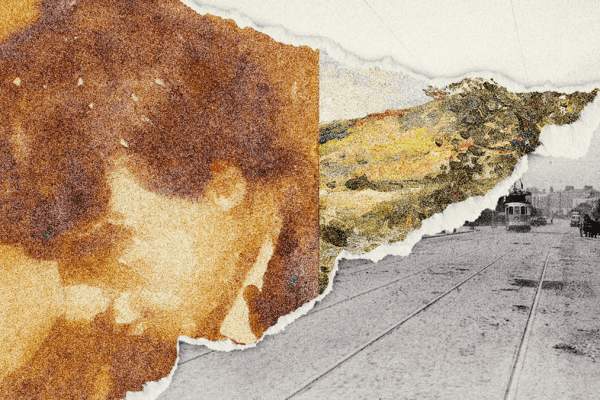Born in Clonlusk, located between Duleek and Donore in County Meath, in January 1882, Peter Hynes’ circumstances were not uncommon when compared with other boys in the surrounding areas.[1] Their fathers worked as farm labourers and life revolved around a necessity to survive, with Hynes’ father having migrated from Derrycammagh in north Louth around a decade before his birth. In the ensuing years, the Hynes family moved again, this time a couple of kilometres north-east towards Drogheda, settling on the Platin Road in Legavoureen while Hynes found a trade as a barber in the town.
Hynes first ran afoul of the law as a 16-year-old, earning a month’s imprisonment in Drogheda Gaol for, as it was simply put, “threatening”.[2] After turning 18, Hynes joined the British Army, grouping with the Royal Irish Fusiliers at Armagh and then Colchester.[3] This was short-lived, though, as just under a year and a half later he was tried for using violence against one of his superior officers, seeing him sentenced to 6 months’ imprisonment and discharged “with ignominy”—essentially meaning bad conduct.
Once his period in the Army came to an end, Hynes returned home and in 1902, married Kate Kevitt of Donore.[4] However, this marriage would prove to be fraught with issues and estrangement, with Hynes continuing to rack up offences for being drunk and disorderly.[5]
On a Razor’s Edge
In March 1907, in Platin, Hynes’ family had just gone to bed for the night. Around an hour later, they were awoken by moans coming from the kitchen. His sister went to investigate and found Hynes lying on the kitchen floor in a pool of blood with a razor by his side. He had slit his throat in an attempt to commit suicide. A doctor attended the scene and Hynes was brought to hospital in Drogheda, where he recovered, though the incident would leave him with a visible scar across his throat.[6]
The ordeal didn’t end there, as back then attempting suicide was deemed illegal. Hynes was brought to trial, being labelled from a spectrum of “ a somewhat eccentric nature” to a “habitual drunkard”.[7] He was found guilty of unlawfully attempting to end his own life and was sentenced to three months in prison with hard labour, which he served in Kilmainham Gaol.[8]
Due to his aggressiveness, not helped by his fondness for alcohol, both Peter’s mother and father were scared of him. This culminated in yet another incident in November 1909. That morning, Hynes and his father, described as “an old deaf man” (he was 60), were in the barn at the family home in Platin where, after a brief exchange of words, the father turned to walk away.
At this moment, Hynes picked up a pitchfork and hit him across the back of the head with it before kicking him down onto the ground. Hynes’ nephew witnessed the scene and ran to Peter Hynes’ mother in the house, crying that his grandfather had been killed. Hynes came in through the door and asked his mother for tea, which she stated in court that she agreed to out of fear. The father then staggered in, covered in blood, and Hynes again leapt up and attacked him, kicking him in the face. She ran out of the house, screaming. and a doctor subsequently attended the scene, taking the father to hospital where he lay in a critical condition for three weeks. A Royal Irish Constabulary (RIC) Inspector who visited him in hospital stated that he appeared to be dying. Though he would later be discharged.[9]
Questions arose during the trial about Hynes’ mental state, with the foreperson of the jury expressing to the judge, “We don’t know your Honour if he is of sound mind or not.” The judge dismissed this and Hynes was sentenced to three years of penal servitude in Maryborough for grievous bodily harm. However, due to a technicality, he was released on 30 January 1910, having only served 13 days.[10]
Yet Hynes’ violent streak continued. In August 1910, he was found guilty of threatening his mother and sentenced to 3 months of penal servitude in Dundalk Gaol.[11] A month after his release, Hynes approached his neighbour, John McLoughlin, at a water pump in Legavoureen, stating, “You went for the police for me.” John replied, “I want nothing to do with you.” Hynes punched him in the face, giving him a black eye, then hit him on his forehead before knocking him down to the ground and releasing a flurry of punches, causing McLoughlin to lose four teeth.[12]
Another month after that, in January, Hynes assaulted his father again and was sentenced to 2 months of hard labour in Dundalk. 4 days after his release, he was brought to trial for his assault on John McLoughlin, earning another 2 months’ hard labour in Dundalk. McLoughlin had refused to prosecute.[12]
Since the trial, though, Hynes had managed to evade arrest. That was until 7 months later, when the RIC were tipped that he was in Drogheda, drunk, and “declaring war on all of Duleek Street.” But when the police arrived he had vanished. He was later spotted on the nearby steps of Pitcher Hill, though when he saw the two RIC men approaching, he dashed into a pub.
The officers split up, one going into the pub while the other went around the back, blocking all exits. Once Hynes emerged through the back door, he encountered the RIC officer. But he managed to go past him and run down the street, with the police continuing to give chase. Aided by two members of the Leinster Regiment from the British Army, they eventually managed to apprehend Hynes and he was sent to Dundalk.[13]
Attack in Bryanstown
Teresa Moore was an unmarried retired grocer living by herself in a two-storey cottage in Bryanstown, neighbouring Platin.[14] On the night of 6 October 1913, she was asleep in her bedroom on the ground floor when she was suddenly awoken by the sound of smashing glass at the back of her house. She stayed put in her bed and heard the sound of footsteps overhead on the first floor.
Suddenly, a man burst into her room and jumped on top of her. She screamed as he tried to choke her. He was only wearing a coat and waistcoat, his stockings, trousers and boots were removed. He beat her head with his fists and threatened to cut her throat. Teresa offered him one pound to leave, along with a pocket watch, the latter of which he turned down. She got off the bed and pretended to look for the money to give him, but the man yanked her by the hair. At this point, she was bleeding heavily from her nose and the top of her head, with her hands scraped.
She managed to reach the hallway outside of her room and opened the front door, where she was again grabbed by her hair as the man stepped in front of her. At the door, he asked her, “Do you know me?” Teresa stayed silent. “I am Peader Hynes.” It was at this point that she realised that the man was her longtime neighbour, stating that she couldn’t make him out initially due to the poor light. He said that he was sorry for what he did to her, but he was angry because his wife left him. Hynes departed without the pound.
Teresa Moore went to a nearby house, Eagle Lodge, and knocked on the door. It was around 3 a.m. Jane Josephine Lynch opened the window and asked who was there. “It is I, Miss Moore. For God’s sake let me in.” She didn’t recognise the voice at first due to it being so weak. She went downstairs and opened the door, and there she saw Teresa in a nightdress. Her hair was clinging around her neck, covered in blood, along with blood across her face. Lynch put her to bed and called for a doctor. The doctor dressed and stitched her wounds sustained in the attack and the next day she was sent to Navan Infirmary. She stayed there for a month and was unable to use her right arm for a few days after the attack due to Hynes twisting it behind her back.[15][16]
The incident was portrayed in an edition of the London-headquartered Illustrated Police News, albeit a more censored version.
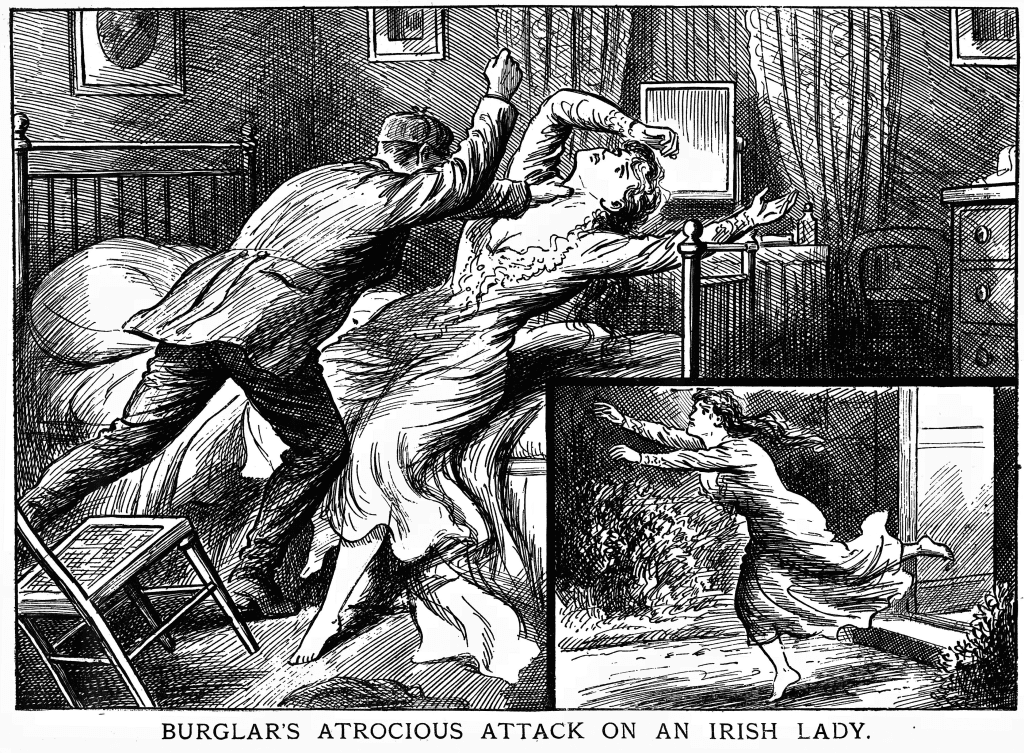
Hynes was not heard from immediately after the incident. That was until late November, almost two months later, when police were called to a house in Broughton, a suburb of Salford, England. The woman who made the complaint said that her brother-in-law was drunk and would not leave the house. Hynes was sitting on the sofa and refused to leave, but eventually acquiesced. Once outside, he was arrested for drunkenness but claimed that his name was William Fay.[16]
As the policeman re-entered the house, an individual handed him a newspaper cutting, presumably detailing Hynes’ crime in Bryanstown. He was brought to a cell in the police station at 10 p.m. that night, continuing to insist that his name was William Fay. At around 4 a.m. he called out to an Inspector, asking if he could see his wife before being brought back to Ireland. The officer refused, retorting, “Why do you want to see her?” Hynes replied, “Oh, I know she has given me away.”
A detective came to his cell the next morning, asking if he was connected to the incident at Bryanstown and also to a burglary in Slane, while searching for identification marks. Hynes denied both. After further questioning, he relented, stating, “I know all about it; it is me they want; you had better tell them I am here; I am Peter Hynes.”
The Salford police sent a wire to Ireland, notifying them of Hynes’ whereabouts. A sergeant and constable from the Duleek RIC barracks then crossed the Irish Sea to arrest him and he was put before the Trim Quarter Sessions. During the trial, he further questioned who had given the Salford officer the newspaper clipping, accusing his “missus” of doing it. He was charged with breaking and entering, indecent and grievous assault, along with attempted rape. He pleaded guilty and earned a sentence of 3 years.[11]
For King and Country
Hynes was released early and was greeted by Europe being in the midst of a war. Aged 34, he decided to re-join the British Army, being attested on 20 April 1916 to the Royal Dublin Fusiliers. On the application form, he stated that he was never a member of any army branch.[17]
He was posted to Cork, but as time had proven throughout his life, trouble was never far away. On the night of 12 June 1916, Hynes left his room in the Cork barracks along with his kit bag and simply scaled the wall before departing, all in sight of other soldiers on duty. He returned 2 days later, sans kit bag. When asked what he did with it plus its contents, he replied, “I sold it”. For this, he was sentenced to 112 days’ detention, being released 48 days early in August 1916.[17]
October saw Hynes stage another desertion. He was caught over a month later and held in civil custody before being sentenced again to 112 days’ detention. Yet another early release saw him join part of the British Expeditionary Force that was posted to France in February 1917. It is unclear, however, if he saw any frontline action. In June, he was admitted to a field hospital for undisclosed mental issues, subsequently entering the 26th General Hospital in Étaples, near Calais. He then made his way from Le Havre to Southampton on the hospital ship SS Warilda, having a stay at Netley Hospital. In January of 1918, he returned to Ireland and was discharged, deemed as being “no longer physically fit for War Services” and earning a military character reference of “bad” on account of his prior desertions.[17]
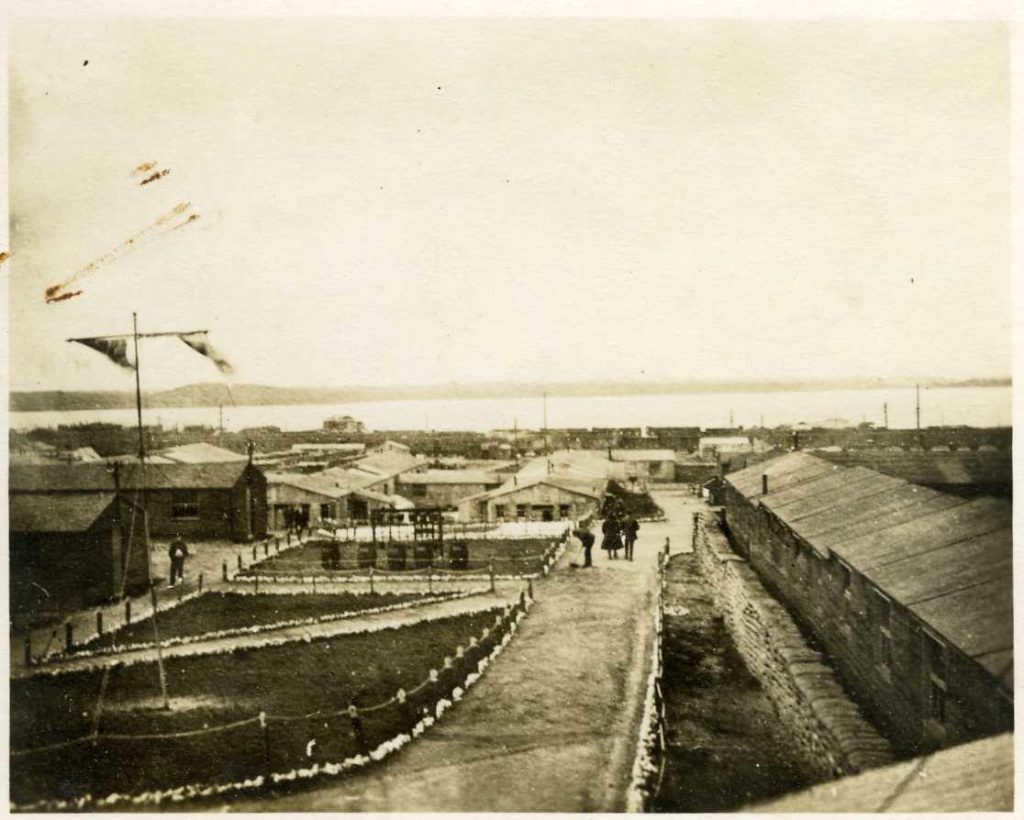
Return to Drogheda
Just over a year and a half later, on 22 September 1920, Constable Mangan and Constable McMahon of the RIC were stationed outside the Tholsel on West Street in Drogheda. They were approached by Hynes, who started hurling foul language at them. He resisted their attempts to arrest him and drew a large knife from his pocket, threatening the pair with it. Next, he proceeded down the street, throwing a piece of machinery from a shop out onto the path. He then turned back towards the Tholsel, kicking some boxes into the middle of the street before entering a shop where, after a struggle, he was apprehended and the knife was taken from him. During the fracas, Constable McMahon’s hand was cut by the knife, while Constable Mangan’s RIC-issued trousers were slashed.[18]
In a court hearing, which Hynes did not attend, they said that the slashed uniform cost £4 and that they were unlikely to ever see the money. It was also remarked that Hynes “had been an inmate of Richmond Lunatic Asylum, and was also an ex-convict, and when he gets drink he becomes mad.”[18] In October 1920, Hynes was sentenced to 28 days in Mountjoy with fines for being drunk and disorderly, as well as damaging Mangan’s trousers. However, as prophesied, he wasn’t able to come up with the money, so an additional 21 days were added to his sentence.[19]
Once released, Hynes had moved to Liverpool and decided to join the workforce again, having sent a letter to the Army requesting a copy of his discharge papers “as they are urgent as I am waiting for work and cannot get work without them.”[17]
He resided in Porter Street, only a couple of streets parallel to his brother. In April 1921, amid industrial disputes with coal miners in northern England, Prime Minister David Lloyd George declared a state of emergency and troops were sent to where miners were striking. The now 39-year-old Hynes took advantage of this opportunity and signed up for 90 days of emergency service as part of the 4th Wiltshire Defence Force.[17]
On 11 June 1921, Hynes was walking back to camp at 10:45 p.m. when he tripped and fell. This incident resulted in him spending a week-long stint in hospital due to a knee contusion and abrasion. An investigation was held to see if the injury was caused purposefully but no blame was attached to him and less than 3 weeks later he was discharged from the army as part of their demobilisation, still holding the rank of Private. This time, his character was described as “good”.[17] He returned to Drogheda and resorted to manual labour roles, not returning to his profession as a barber.
The Final Act
At this point, Ireland had begun a seismic shift. The Irish War of Independence had ended, with the Anglo-Irish Treaty being signed as Ireland transitioned to the Irish Free State, including the disbandment of the RIC and its divisions. One demobilised member was Thomas Grimstone, a 26-year-old originally from Durham, England. He had just been discharged from his position in the Navy and Army Canteen Board in Cootehill, Cavan, and was on his way towards Drogheda to look for work. It was Sunday, 8 January 1922, and Grimstone needed a place to stay. He ended up on the Platin Road and knocked on the door of Robert Dyas, asking him for lodgings, which he granted. He remained there until Saturday, when Dyas informed him that he had to leave that evening due to his wife returning home.
Once he left, he searched for another place to stay. One homeowner turned him down because he didn’t want to get out of bed. He then approached a boy standing at the door of a neighbouring house, but he too said no, partly due to his mother being a widow, which would have been seen as scandalous by the neighbours. At this moment, Peter Hynes came by, singing “If you’re Irish come into the parlour”. He greeted the pair before questioning Thomas, “Are you an Irishman?” Grimstone said yes. He then asked if he was going home, with Grimstone stating that he didn’t have a home to go to. Hynes replied, “Come along with me and I won’t see you out.” So the two men bid the boy goodnight and went on their way.[20]
Hynes took Grimstone to his nearby abode—a stable belonging to Thomas Finlay, a veteran of the Crimean War who was reputed to have sounded the bugle for the Charge of the Light Brigade. Hynes had been sleeping in the stable with Finlay’s goats. Grimstone rolled up his jacket to use as a makeshift pillow and went to sleep.
While the reason is unclear and is only based on Hynes’ account, who it can be assumed is an unreliable narrator, he took an iron bar that was in the shed and beat Grimstone to death with it, striking his skull multiple times to the point where a witness referred to it as “little more than a mass of congealed blood.”[21] Hynes then hid the weapon, covered the corpse in hay and slept on top of him for the remainder of the night. The next morning, Hynes went to Finlay’s house and had breakfast with him. He asked Hynes who he was with in the stable the previous night, as he thought he heard two voices, but Hynes said it was only him.
On Sunday evening, Hynes went to his brother-in-law, Walter Coombes’ house nearby and had tea with him. Here, Hynes told him that he found “a Black and Tan” in his bed the previous night, adding, “and I may tell you he is dead now.” He described how he killed him and asked Walter if he could help dispose of the corpse. He refused to and so Hynes walked away, muttering that he would take care of the body himself.
On Monday morning, Hynes set off to his new occupation as a labourer. He met a co-worker along the way and they walked to the workplace together. Once they were a bit up the road, Hynes informed his co-worker, William Callaghan, that he had a secret to tell him.
He recounted the same story he had told his brother-in-law: that when he went to his usual stable, there was a Black and Tan in his bed. He asked what he was doing there and Grimstone replied that he was “all right there.” Then he saw Grimstone putting his hand down his side as if he were looking for a revolver. It was at this moment that Hynes spotted an iron bar behind the shed door. He grabbed it, struck Grimstone across the throat with it twice, then hit him two more times across his cheeks. He then covered up the body with hay and slept on top of him.[20][22]
Hynes asked Callaghan to help him dispose of the body, to which he agreed, as he stated later in court that he was afraid of him. Hynes had a few ideas for what to do with Grimstone. One was to throw him into a nearby quarry. Another was to put the remains in hay and set it alight. A third was to throw him into a heap of briars and let rats eat the corpse. That evening, Callaghan informed the Irish Republican Police (IRP) of what Hynes had told him.
A combination of IRP and RIC personnel were dispatched to the scene. They met Hynes on the road on their way to the location and he was detained. They found Grimstone’s corpse lying by the wall inside the shed, covered by hay, along with a bloodstained iron bar close by. Letters were found in Grimstone’s pockets, as well as an unemployment card, scapulars and rosary beads.[23] Hynes was arrested for murder. He was first held in custody in Dundalk before being transferred to Mountjoy in July 1922.[24]
His trial wouldn’t take place for another 14 months. In November 1923, Hynes went before a judge and jury to determine his fate. The future Chief Justice of Ireland, Conor Maguire, was assigned to defend Hynes.
Here, the facts of the case were reiterated. Maguire argued that the evidence in question was circumstantial and that the prosecution’s evidence was solely based on Hynes’ statements. He further added that there was no murderous intent behind the act and that Black and Tan was a “name of terror” at the time, which would have given Hynes’ action some credence if his suspicions were believed to be true, coupled with the claim that he was drunk at the time. This was dismissed as there was no plea of self-defence by Hynes. The Lord Chief Justice added that it would be “fatal” if a plea of drunkenness was accepted in every criminal case.[23]
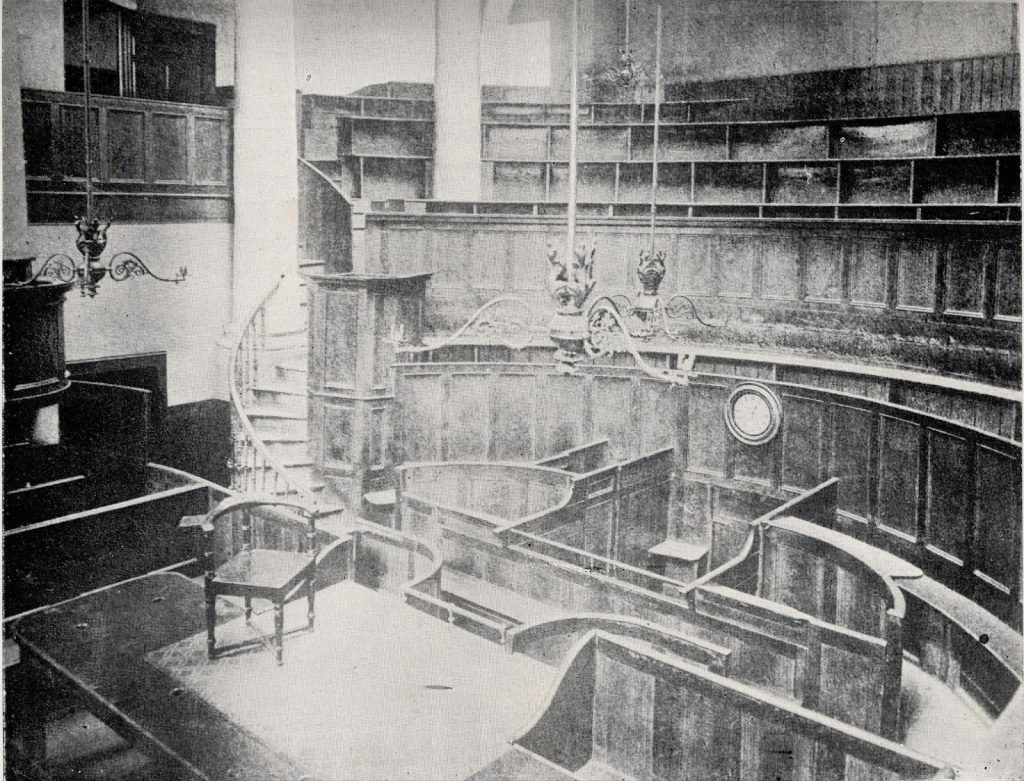
The jury deliberated for 15 minutes. Upon their return, they gave a verdict of guilty. When asked if there was any reason why he shouldn’t be executed, Hynes replied, “All I have to say is it is time the job was finished.” Hynes was sentenced to be hanged on December 15th, one month from then. As he left the dock, he sneered and exclaimed, “The good old country.”[23]
Drogheda locals argued that Hynes should have been deemed criminally insane. Father John Nulty of Hynes’ parish church described him as:
“A dangerous character, and one that should not be at large being in fact a homicidal maniac… it is felt by many that he is more of a maniac than a murderer. I have been told that years ago he attempted murder, that he also attempted parricide and suicide and that his demeanour then and since would show that he did not and does not realise his crimes.”[25]
A report from the Garda Chief Superintendent drew on Hynes’ litany of previous convictions, concluding that:
“It is agreed by all [in Drogheda] that he was a desperate, callous man, and much imbued with low, immoral tendencies, but at the same time they will all maintain that he was anything but sane, and state years ago he should have been in safe quarters.”[25]
However, these concerns were quashed by Dr William Donnellan from the “Lunacy Office”, who stated that while Hynes was a “moral degenerate”, he was not suffering from hallucinations or delusions.
Hynes’ Denouement
In the early hours of Saturday morning, 15 December 1923, Hynes awoke in his cell knowing it was his last day on Earth. There, Mass was celebrated at 7 a.m., which he followed attentively while praying fervently.[26] He left his cell, flanked by two priests, continuing to pray as he arrived at the scaffold where two prisoners had been hanged three days prior.
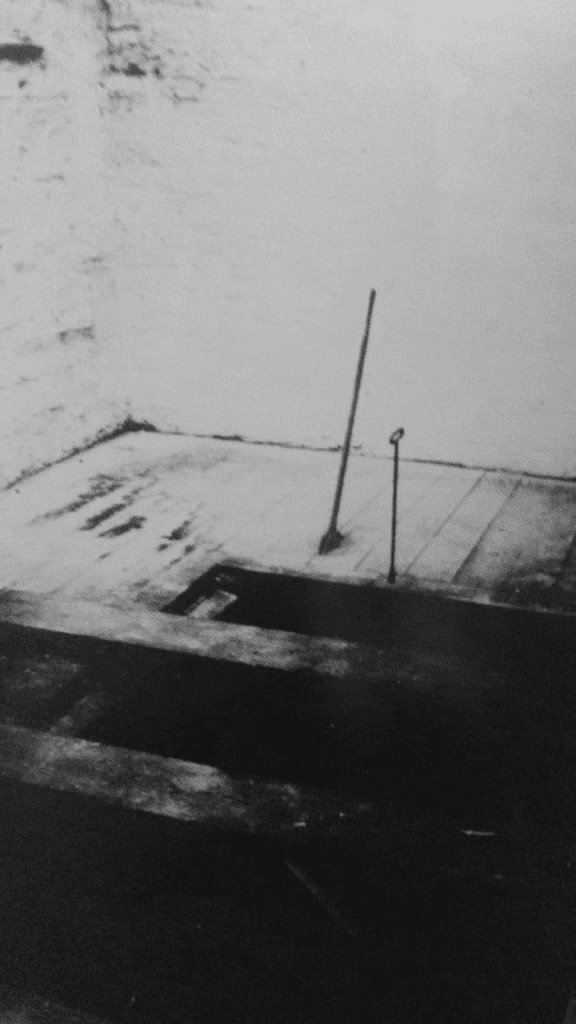
There he stood beside Thomas Pierrepoint, a member of the infamous English family dynasty of executioners. Pierrepoint prided himself on his efficiency and business-like approach to hanging, claiming his record from cell to gallows was 60 seconds.[27]

executioner
Hynes’ wrists and legs were bound by Pierrepoint’s assistant; a hood was placed over his head, and the noose was placed around his neck. Save for the members involved in the execution, there was no public interest in the event. No curiosity seekers and no relatives were present. The only sign that a hanging was about to take place was a couple of journalists outside the prison gates, along with two Dublin Metropolitan Police constables.[26][28] Once the time had hit 8 o’clock, Pierrepoint released the safety latch, drew the bolt back, and all 61 kilograms of Peter Hynes was sent plummeting down.
References
- Department of Tourism, Culture, Arts, Gaeltacht, Sport and Media. “Civil Records—Births in Drogheda.” Irish Genealogy, n.d. https://civilrecords.irishgenealogy.ie/churchrecords/images/birth_returns/births_1882/02795/2025778.pdf
- “Irish Prison Registers 1790-1924.” January 7, 1910. Database and images. Find My Past.
- “Wo 363—First World War Service Records ‘Burnt Documents’.” Database and images. Find My Past.
- Department of Tourism, Culture, Arts, Gaeltacht, Sport and Media. “Civil Records—Marriages in Drogheda.” Irish Genealogy, n.d.
https://civilrecords.irishgenealogy.ie/churchrecords/images/marriage_returns/marriages_1902/10273/5738955.pdf - “Duleek Petty Sessions: Drunk and Disorderly,” Drogheda Independent, April 1, 1905, 6.
- “Tragic Occurrence Near Drogheda: Barber Attempts Suicide,” Drogheda Conservative and General Advertiser, March 30, 1907, 5.
- “Ireland, Petty Sessions Court Registers—Duleek.” May 11, 1907. Database and images. Find My Past.
- “Irish Prison Registers 1790-1924.” 1907. Database and images. Find My Past.
- “Father Savagely Assaulted,” Drogheda Independent, January 15, 1910, 2.
- “Irish Prison Registers 1790-1924.” 1910. Database and images. Find My Past.
- “Irish Prison Registers 1790-1924.” January 9, 1914. Database and images. Find My Past.
- “Assaulting His Father,” Drogheda Independent, March 11, 1911, 2.
- “Man Hunt in Duleek Street,” Drogheda Independent, October 21, 1911, 4.
- “1911 Census of Ireland”, County: Meath, DED: St. Mary’s, Townland/Street: Bryanstown, House 12
- “Recent Assault on a Drogheda Lady,” Drogheda Independent, December 6, 1913, 6.
- “Julianstown Petty Sessions: Hynes Sent for Trial,” Drogheda Independent, December 20, 1913, 7.
- “Wo 363—First World War Service Records ‘Burnt Documents’.” Database and images. Find My Past.
- “Drogheda Petty Sessions: A Dangerous Character,” Drogheda Independent, October 23, 1920, 3.
- “Ireland, Petty Sessions Court Registers—Drogheda.” October 18, 1920. Database and images. Find My Past.
- “Tommy the Soldier,” Drogheda Argus, February 4, 1922, 6.
- “The Fifth Death Sentence: Another Ghastly Murder Story at Dublin Commission,” Belfast Newsletter, November 16, 1923, 7.
- “Cootehill Man’s Fate,” Northern Standard, January 20, 1922, 8.
- “The Platten Murder,” Drogheda Independent, November 24, 1923, 2.
- “Irish Prison Registers 1790-1924.” 1923. Database and images. Find My Past.
- Doyle, David M., and Liam O’Callaghan. Capital Punishment in Independent Ireland: A Social, Legal and Political History. Liverpool University Press, 2019. https://doi.org/10.2307/j.ctv128fp67.
- “Meath Murder,” Freeman’s Journal, December 17, 1923, 2.
- Bushe, Andrew. “Pierrepoint Boasted about Hanging Record.” Irish Independent. June 10 2007. www.independent.ie/irish-news/pierrepoint-boasted-about-hanging-record/26296687.html.
- “Meath Man Hanged,” Drogheda Independent, December 22, 1923, 9.
